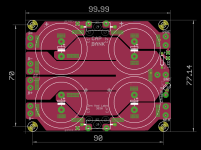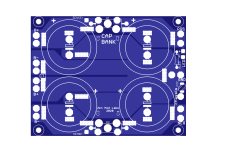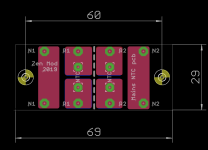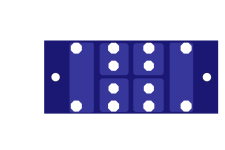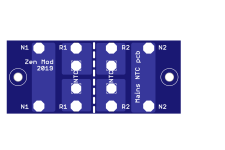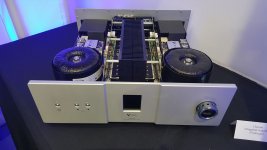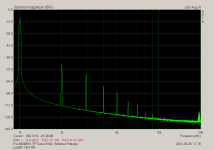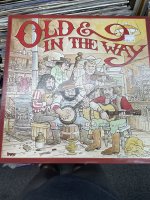HA! means Handy Addendum
consisted of pair of Cap Bank pcbs and pair of mains NTC pcbs
Cap Bank pcb- CRC per rail, led resistor and led pads, small NTC (10mm Dia) between audio GND and chassis; each C snap-in, max Dia 35mm
NTC pcb - dual - so each pcb covers either dual primary Donut with 1 NTC per winding, or covering two Donuts in case of single primary; NTCs are CL60 format/size
some graphical info, present in most of my Trade threads for amps but anyway
consisted of pair of Cap Bank pcbs and pair of mains NTC pcbs
Cap Bank pcb- CRC per rail, led resistor and led pads, small NTC (10mm Dia) between audio GND and chassis; each C snap-in, max Dia 35mm
NTC pcb - dual - so each pcb covers either dual primary Donut with 1 NTC per winding, or covering two Donuts in case of single primary; NTCs are CL60 format/size
some graphical info, present in most of my Trade threads for amps but anyway
Attachments
Okay, got it and thanks for clearing up. I have some ideas for my own PSU, but didn't want to clutter the thread until I had everything down and then share, for better or for worse 😉. But its clear I am going to include a smart soft start circuit, maybe a snubber, followed by active full bridge rectifier, either a CLC or CRC (have not decided yet) and lastly a cap bank. All on a main PSU PCB per side as in dual mono, and found a layout I think will work great for a dual mono configuration - see attachment. Should aid in chn separation. Keeping the heatsink in the middle allows for better separation of components and any EM fields generated by any side.
But what is Zen's take on CRC vs CLC - are they the "same" or are there clear advantages for one over the other ?
But what is Zen's take on CRC vs CLC - are they the "same" or are there clear advantages for one over the other ?
Attachments
Teabag has blog here. Just an 8 cap power supply board I bought several of a while back.
I don't know what HA boards are, that's what I am asking about. They were an option, and I always get the option that includes the most parts.
Russellc
I don't know what HA boards are, that's what I am asking about. They were an option, and I always get the option that includes the most parts.
Russellc
see, in principle, what I prefer
post #908 https://www.diyaudio.com/community/threads/ludef.369990/post-6997306
just one of posted; I took care to have all necessary info shown on pics:

post #908 https://www.diyaudio.com/community/threads/ludef.369990/post-6997306
just one of posted; I took care to have all necessary info shown on pics:
Simple and straight forward - and it looks like you are using CLC here. There is a lot of talk about this amplifier (LuDef), a favorit perhaps ?
What strike me about the LuDEF compared to XA252 SET (shaded) is how much closer the LuDEF is to a triodes THD .. and now I cannot unseen... 😳 😆
Triode picture source: https://www.valvewizard.co.uk/Common_Gain_Stage.pdf
What strike me about the LuDEF compared to XA252 SET (shaded) is how much closer the LuDEF is to a triodes THD .. and now I cannot unseen... 😳 😆
Triode picture source: https://www.valvewizard.co.uk/Common_Gain_Stage.pdf
Attachments
measure of my stubbornness and inability to move from beaten path is - I'm always striving to:
-dominant 2nd
-preferably negative phase of same
-spanning that THD Spectra to entire power range, meaning - 3rd never becoming dominant or maybe just on highest power levels
now, THD Level really depends of entire concept of amp itself, but one can only be surprised at start, realizing how similar** are two amps sounding, even in case when one is having minuscule THD (XA252 for instance) and other one practically being THD generator (SissySIT for instance)
under condition that testing is made on speakers adequate for both amps
**not really searching for sweetness (often related to high THD SET amps) but more for level of fun factor and immediacy
favorite amp of mine - as "model" - as Pa said more than once - "this one I'm working now on"
as exact specimen - amps I got as gift from Pa - Papa's Koan and DEFiSIT
fact that DEFiSIT is rare as Hen tits and certainly sole specimen in Europe and maybe even out-of-US is irrelevant - both are unique for me
I mean, amps are irrelevant, gift of Love is preciousssssss

-dominant 2nd
-preferably negative phase of same
-spanning that THD Spectra to entire power range, meaning - 3rd never becoming dominant or maybe just on highest power levels
now, THD Level really depends of entire concept of amp itself, but one can only be surprised at start, realizing how similar** are two amps sounding, even in case when one is having minuscule THD (XA252 for instance) and other one practically being THD generator (SissySIT for instance)
under condition that testing is made on speakers adequate for both amps
**not really searching for sweetness (often related to high THD SET amps) but more for level of fun factor and immediacy
favorite amp of mine - as "model" - as Pa said more than once - "this one I'm working now on"
as exact specimen - amps I got as gift from Pa - Papa's Koan and DEFiSIT
fact that DEFiSIT is rare as Hen tits and certainly sole specimen in Europe and maybe even out-of-US is irrelevant - both are unique for me
I mean, amps are irrelevant, gift of Love is preciousssssss
2nd order harmonics (even) is pleasure and why so many including me, like triodes. 3rd order harmonics (odd), brings clarity but can sound harsh if too present. Most natural instruments have similar harmonic decay to a triode... Theoretically, LuDEF should be more pleasing.
Papa's Koan is a FW M2 variant ?
Papa's Koan is a FW M2 variant ?
Theoretically, LuDEF should be more pleasing.
pleasing yes
but, really matter of personal preference; remember - some people are best liking Halcro driving Wilsons
I have no objection, to anyone's taste, as long there is no finger pointing to my nose, urging me to embrace the preachment
Papa's Koan is a FW M2 variant ?
Papa's Koan
DEFiSIT
Halcro are amplifiers and Wilson are loudspeakers .. really expensive stuff.
Musical vs clinical is another way to look it and I need to go over those threads as well as LuDEF and Babelfish M25, AKA M2 on steroids
At one point my intention was to build VacuumState Electronics DPA-300B and use it on tweeter/midrange and a GamuT D200i on midrange/woofer - combo depend on loudspeaker architecture. The XA252 replaces the GamuT and I am wondering if LuDEF replaces DPA-300B ... hmm "solid state tube"
Musical vs clinical is another way to look it and I need to go over those threads as well as LuDEF and Babelfish M25, AKA M2 on steroids
At one point my intention was to build VacuumState Electronics DPA-300B and use it on tweeter/midrange and a GamuT D200i on midrange/woofer - combo depend on loudspeaker architecture. The XA252 replaces the GamuT and I am wondering if LuDEF replaces DPA-300B ... hmm "solid state tube"
I'm too old and too busy and too much laid back ..... to mess with any sort of active system
finding that with adequate speaker drivers I can stay with passive xover + one amp, and be happy
there are so many great speakers around, even if I stay with boiled water , I'm good
decent FR, or decent dual concentric , for us Geezers ......
finding that with adequate speaker drivers I can stay with passive xover + one amp, and be happy
there are so many great speakers around, even if I stay with boiled water , I'm good
decent FR, or decent dual concentric , for us Geezers ......
Found this at a shop the other day... Most of the time I'm not in the way...for us Geezers ......

Attachments
@Zen Mod I wasn't necessarily thinking active but bi-amping in the example I used. But fully active is also on my mind. These things are usually very personal and it all depends.
What I am curious about is the elevated triode behaviour of the LuDEF and where it comes from, which circuit parts or components are responsible. Like I said, I need to go over the threads and take notes to understand what separates OR link the amplifiers.
No matter, thanks a million for all your efforts Zen 🙂
What I am curious about is the elevated triode behaviour of the LuDEF and where it comes from, which circuit parts or components are responsible. Like I said, I need to go over the threads and take notes to understand what separates OR link the amplifiers.
No matter, thanks a million for all your efforts Zen 🙂
cascoded LU is practically super-pentode, when thinking of transfer-characteristics
triodish transfer characteristic of entire amp is primarily result of DEF OS transfer characteristic, and more (random) details about that you can get from above linked DEFiSIT thread
it is normal to think of complementary follower OS as we are used to do, striving for most symmetric parts and expecting least amount of THD
now, Pa (even if not first to try it) scope that from different angle - he deliberately chose to use dissimilar parts in "complementary" follower, and having desirable THD SPectra as result
so, me Thief as I am, later tried all sorts of combinations - SIT up/mosfet down, Schaded mos/up mos down, mos up/Ge down, mos up/bjt down ........
one can use bjt darlington in place of cascoded LU and get pretty much same results
all roads are leading to Rome ..........
to get it mentally, all you need to grasp is - just think of xconductances of parts in OS follower; observing OS itself, when upper is having lesser xconductance, you get 2nd dominant with neg phase; when lower is having lesser xconductance, you get 2nd dominant with positive phase
though, phase is not so important; as Papa did show in the past - flip speakers phase and you're flipping dominant phase
triodish transfer characteristic of entire amp is primarily result of DEF OS transfer characteristic, and more (random) details about that you can get from above linked DEFiSIT thread
it is normal to think of complementary follower OS as we are used to do, striving for most symmetric parts and expecting least amount of THD
now, Pa (even if not first to try it) scope that from different angle - he deliberately chose to use dissimilar parts in "complementary" follower, and having desirable THD SPectra as result
so, me Thief as I am, later tried all sorts of combinations - SIT up/mosfet down, Schaded mos/up mos down, mos up/Ge down, mos up/bjt down ........
one can use bjt darlington in place of cascoded LU and get pretty much same results
all roads are leading to Rome ..........
to get it mentally, all you need to grasp is - just think of xconductances of parts in OS follower; observing OS itself, when upper is having lesser xconductance, you get 2nd dominant with neg phase; when lower is having lesser xconductance, you get 2nd dominant with positive phase
though, phase is not so important; as Papa did show in the past - flip speakers phase and you're flipping dominant phase
See, now that is exactly the point which engineers should take note of. Only a narrow minded engineer would compete in a race to the bottom and seek a 0.000000005% THD value for home audio. In the real world, this makes no sense. 0.5-0.05% is more than sufficient because what matters in the end is if the amplifier is true to life or the recording, or if it sucks the life out of everything. THD and S/N are different animals.
While we can tolerate a fairly high THD, what makes a good amp is a low S/N. The more quiet the background is, the better, since background noise is an unwanted child.
There is a reason why people still listen to tubes: They are perfectly unperfect and while I have not listened to any of your amps yet, the science is clear on this one. But tubes are consumables and need to be replaced from time to time, so to be able to reproduce a triodes THD profile is outstanding. Thanks for the clarification.
While we can tolerate a fairly high THD, what makes a good amp is a low S/N. The more quiet the background is, the better, since background noise is an unwanted child.
There is a reason why people still listen to tubes: They are perfectly unperfect and while I have not listened to any of your amps yet, the science is clear on this one. But tubes are consumables and need to be replaced from time to time, so to be able to reproduce a triodes THD profile is outstanding. Thanks for the clarification.
main thing with tubes is that they're so forgiving ...........
and even if so abused that they're going south very quick, they're dying softly without making any damage to rest of equipment
I've seen in vivo, and even more on paper or screen - so many incompetently designed gadgets with tubes, some of them even sold for big money ..........
anyhow - good amp is good, it really doesn't matter what active parts are inside ..... and it is measure of designer's ability, not parts used and their intrinsic goodness
and even if so abused that they're going south very quick, they're dying softly without making any damage to rest of equipment
I've seen in vivo, and even more on paper or screen - so many incompetently designed gadgets with tubes, some of them even sold for big money ..........
anyhow - good amp is good, it really doesn't matter what active parts are inside ..... and it is measure of designer's ability, not parts used and their intrinsic goodness
main quality of tube gadgets is not in their superiority as active devices, but from fact that most tube gadgets are made in a way that signal path is relatively simple and short, thus signal being conditioned in minimalistic fashion/measure
combine that with usually "soft" THD ...... result of fact that tubes are having mild saturation character (not so abrupt as semis) and there it is ...
take as example good old ECC88/6DJ8/PCC88/7DJ8
sweet and common is 90Vc-a and about 9mA
kill anode supply ....... or even better - push it via Variac , dial down to 12V and old goodie will still sing - if output swing is not demanding, it'll still sing with almost all sweetness and authority
conclusion - everyone and his neighbor are able to make decent tube preamp or amp; someone's neighbor even made a business from that, selling mediocre gadgets for big money
go wild, make complicated tube amp ...... in the end it'll sound pretty much the same as complicated SS amp
combine that with usually "soft" THD ...... result of fact that tubes are having mild saturation character (not so abrupt as semis) and there it is ...
take as example good old ECC88/6DJ8/PCC88/7DJ8
sweet and common is 90Vc-a and about 9mA
kill anode supply ....... or even better - push it via Variac , dial down to 12V and old goodie will still sing - if output swing is not demanding, it'll still sing with almost all sweetness and authority
conclusion - everyone and his neighbor are able to make decent tube preamp or amp; someone's neighbor even made a business from that, selling mediocre gadgets for big money
go wild, make complicated tube amp ...... in the end it'll sound pretty much the same as complicated SS amp
- Home
- Amplifiers
- Pass Labs
- Babelfish XA252 / Babelfish XA252 SIT / Babelfish XA252 SET
